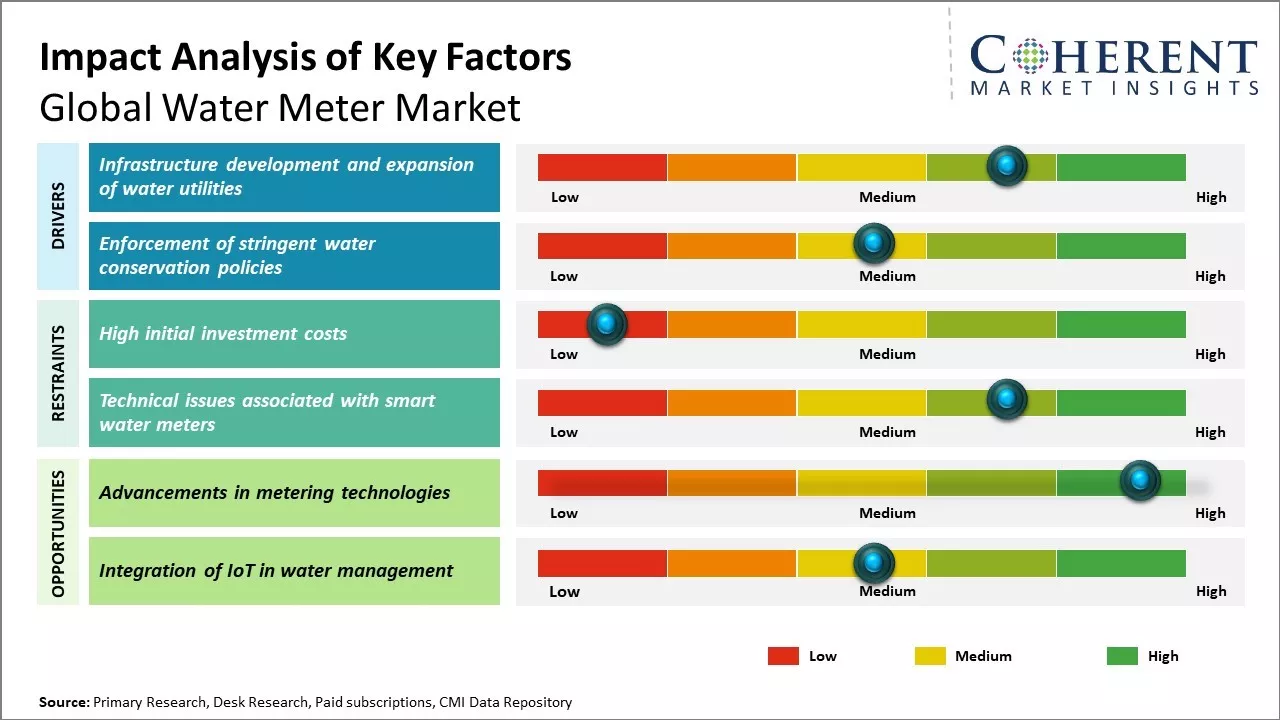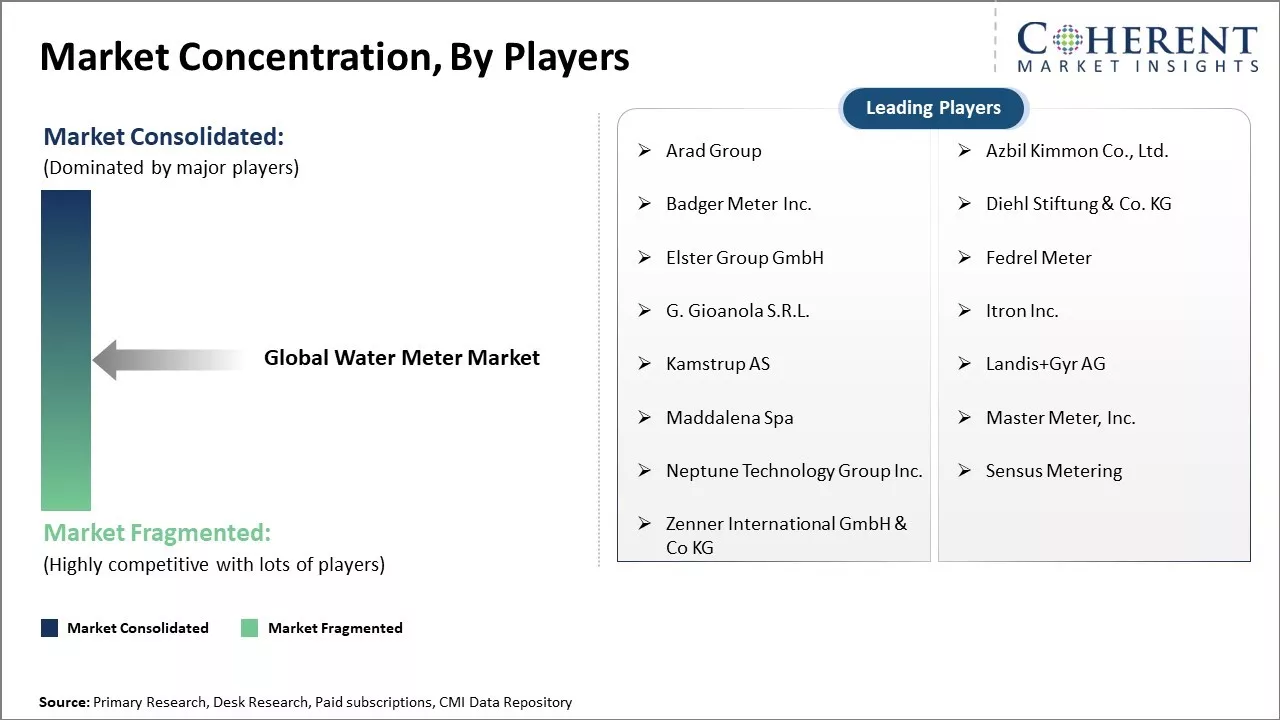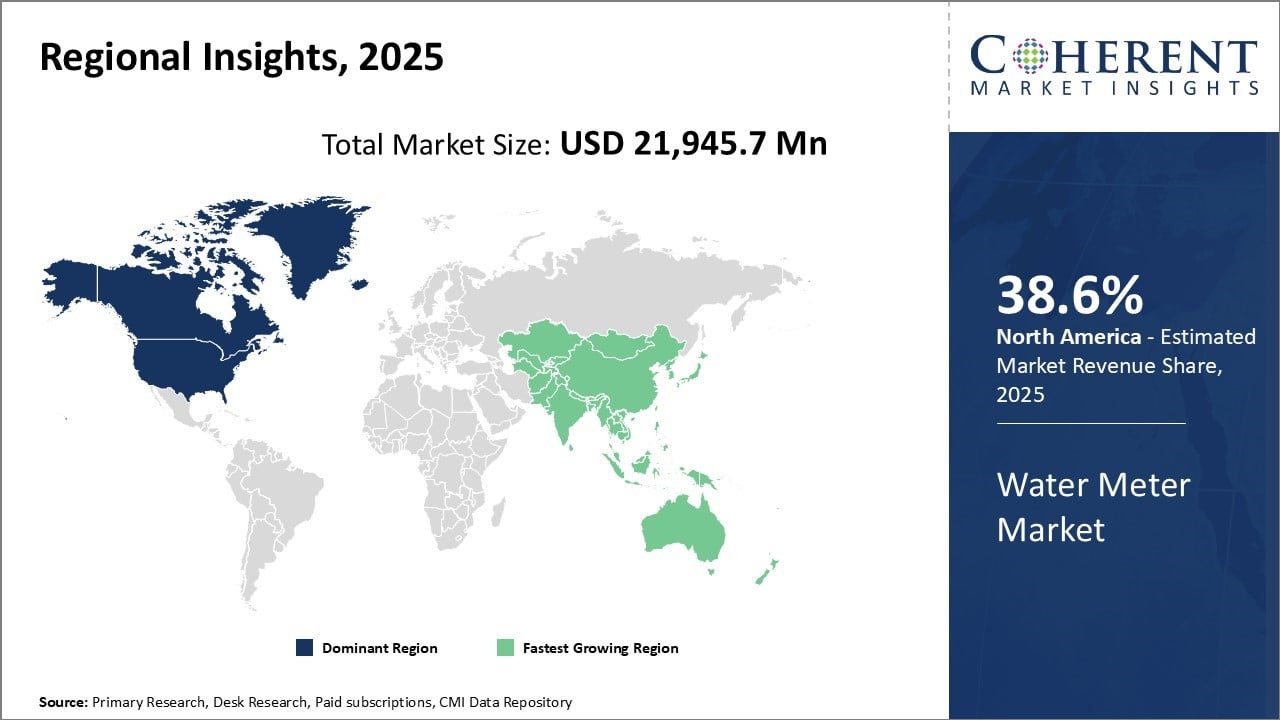The Global Water Meter Market size is estimated to be valued at USD 21,945.7 Mn in 2025 and is expected to reach USD 32,371.5 Mn by 2032, exhibiting a compound annual growth rate (CAGR) of 5.7% from 2025 to 2032.

To learn more about this report, Download Free Sample
The worldwide demand for water meters is being driven by rising concerns over water conservation as well as the growing focus on modernizing infrastructure. In relation to existing climate change issues, there is an increased investment in advanced smart water management systems making the water meter market poised for further growth in the coming years. The real-time automated transmission of usage data through smart water meters will fully automate data collection enhancing operational efficiency and customer satisfaction.
|
Event |
Description and Impact |
|
Global Water Scarcity Crisis and Climate Change Impacts |
|
|
Smart City Initiatives and Digital Infrastructure Development |
|
|
Regulatory Changes and Environmental Compliance Requirements |
|
Uncover macros and micros vetted on 75+ parameters: Get instant access to report

To learn more about this report, Download Free Sample
The expansion of infrastructure to provide water utilities is not keeping pace with the rapidly growing urban population. In developing countries, cities and municipalities are working to expand their water distribution networks by installing new pipelines that connect to additional households and commercial centers.
Governments in Southeast Asia and Africa are significantly investing in water supply systems, recognizing the need to provide potable water for public health and critical socio-economic development. With metered connections, utilities are able to recover operational and infrastructure development costs more sustainably through consumption-based tariffs.
Existing resources can be optimized, and non-revenue water losses can be minimized. The advanced metering solutions with wireless links improving remote network monitoring, leak detection, and repair scheduling are becoming popular. Water meter manufacturers and system integrators now have abundant opportunities because the global demand for universal access to water presents a growing need.
Indeed, the available freshwater resources are under threat in the majority of the world due to increased population levels and urbanization, usage of resources in inefficient ways, the impacts of climate change in the form of erratic monsoons and droughts, as well as droughts. In several cities facing extreme water scarcity, local governments have been enforcing laws requiring the installation of meters for both residential and business water connections.
Lawmakers are also providing stricter enforcement on allowable consumption thresholds and imposing heavy penalties for overuse or wastage. From a compliance standpoint with applicable laws and regulations, meeting the defined benchmarks has become critical for construction permits or occupancy certificates which poses challenges for building owners and property developers.
Prescriptive policies including advanced metering infrastructure greatly aid the enforcement of water conservation policies and motivate efficient usage of scarce resources. Water Smart meters with two-way communication capabilities, data analytics, and appliance-level detail provide expenditure insights down to the appliance-level. Leakages, thefts, and wastage are easy to identify due to the detection of oddly high usage.
The global water meter market can greatly benefit from new metering technologies. Innovative methods of monitoring and managing water usage are crucial as the world strives to combat water scarcity problems. These challenges are being resolved by technological advancements, especially in measurement and monitoring systems. The development of smart metering infrastructure is particularly remarkable.
These next-generation smart water meters combine sophisticated sensors with advanced communication systems and analytics. Unlike traditional mechanical water meters, smart meters enable automated and remote reading. Utilities can now collect accurate and timely data on water consumption from individual homes or buildings at a far greater frequency than before.
Data analysis can provide insights on usage patterns, leak detection, and assist in predictive maintenance scheduling. Smart water meters and related technologies enable utilities to remotely disconnect and reconnect, allowing better demand management and supply optimization.
The rotary piston segment commands the 24.6% share of the global water meter market in 2025 due to its proven reliability and accuracy. Rotary piston meters work by utilizing a rotating piston within a measuring chamber to shuttle water in two separate metering paths. As water flows through the paths, the piston turns, recording the volume consumed.
This mechanical design ensures stable and reliable water metering performance over time, even in varying pressure and water flow conditions. Rotary piston meters register water usage accurately at high and low flows. Their dual turbine paths guarantee constant measurement precision whether a residence’s water consumption is minimal or over a sustained period.
The residential segment claims the 42.3% share of the global water meter market in 2025 owing to continuous consumption patterns in single-family homes. Whereas commercial and industrial premises experience variable usage depending on business activity levels, residential properties demand a steady supply of water daily for basic needs. Every home requires water for activities like cleaning, cooking, drinking, bathing, and outdoor maintenance no matter the fluctuations in broader economic conditions.
Consistent daily consumption in millions of households worldwide translates into a very high collective volume of water utilized for residential purposes. Utilities have therefore prioritized installing accurate metering infrastructure to account for and bill this substantial residential demand. Homeowners themselves also want to track their usage to monitor for any leaks or unnecessary waste. The regularity of day-to-day residential consumption compared to intermittent commercial/industrial usage habitually drives higher investment in water metering at domestic properties.

To learn more about this report, Download Free Sample
North America has secured its position as the dominant region in the global water meter market, projected to hold a 38.6% share in 2025. This leadership is driven by the presence of major manufacturers such as Badger Meter and Sensus, whose strong regional foothold supports widespread adoption.
Regulatory mandates focused on water management and conservation have accelerated replacement programs for outdated meters across U.S. and Canadian municipalities, generating steady demand. Additionally, ongoing efforts to modernize aging water infrastructure continue to create investment opportunities.
The region is also at the forefront of deploying advanced metering infrastructure (AMI) and smart water technologies, with utilities increasingly integrating Internet of Things (IoT) and wireless communication features into new meters. This technological push, combined with stable economic conditions and a well-established supply chain, sustains North America’s advantageous market environment.
Asia Pacific is emerging as the fastest-growing regional market for water meters, propelled by pressing needs for sustainable water management across developing countries. Rapid urbanization, expanding industrial water consumption, and heightened public health awareness are driving increased meter installations.
Many countries in the region face significant non-revenue water issues caused by leakages and theft, prompting government-led initiatives to upgrade distribution systems. Rising affluence is also motivating greater investments in water conservation technologies. Manufacturers view Asia Pacific as a high-potential market due to its relatively early stage of meter deployment compared to mature Western markets.
Favorable government policies and lower production costs have further encouraged global suppliers to expand local manufacturing facilities. If these trends continue, Asia Pacific is positioned to challenge North America’s market dominance in the near future.
The United States is the largest contributor to North America’s water meter market. Its leadership stems from extensive municipal programs aimed at replacing legacy meters with advanced, smart metering solutions. The country’s strong regulatory framework and focus on sustainable water management foster ongoing investments.
Leading manufacturers headquartered in the U.S. benefit from advanced R&D capabilities and close collaboration with utilities, driving innovation in IoT-enabled meters and analytics platforms. This creates high demand for sophisticated products that enhance operational efficiency and water conservation efforts.
Canada complements the regional market with consistent demand driven by government initiatives targeting water loss reduction and infrastructure upgrades. Canadian utilities are increasingly adopting smart water metering technologies to improve billing accuracy and reduce non-revenue water. The presence of local manufacturers and suppliers supports regional supply chains and product customization for diverse climatic and municipal needs.
China is a key growth driver within Asia Pacific, propelled by rapid urbanization, industrialization, and government policies focused on water conservation. The country faces significant challenges with non-revenue water, motivating large-scale modernization of distribution networks.
Domestic manufacturers are rapidly expanding smart meter production capabilities, supported by favorable policies and investments in technology. China’s competitive manufacturing landscape and vast infrastructure projects position it as a crucial hub for the regional water meter market’s growth.
India’s water meter market is growing robustly, fueled by government-led programs to address water scarcity and improve resource management. Initiatives like the Smart Cities Mission promote the adoption of advanced metering infrastructure, encouraging utilities to replace manual meters with smart alternatives.
The expanding urban population and rising industrial demand further support growth. India’s manufacturing sector benefits from lower production costs and increasing collaboration with global technology providers, positioning it as an emerging manufacturing and consumption hub in the region.
| Report Coverage | Details | ||
|---|---|---|---|
| Base Year: | 2024 | Market Size in 2025: | USD 21,945.7 Mn |
| Historical Data for: | 2020 To 2024 | Forecast Period: | 2025 To 2032 |
| Forecast Period 2025 to 2032 CAGR: | 5.7% | 2032 Value Projection: | USD 32,371.5 Mn |
| Geographies covered: |
|
||
| Segments covered: |
|
||
| Companies covered: |
Arad Group, Azbil Kimmon Co., Ltd., Badger Meter Inc., Diehl Stiftung & Co. KG, Elster Group GmbH, Fedrel Meter, G. Gioanola S.R.L., Itron Inc., Kamstrup AS, Landis+Gyr AG, Maddalena Spa, Master Meter, Inc., Neptune Technology Group Inc., Sensus Metering, and Zenner International GmbH & Co KG |
||
| Growth Drivers: |
|
||
| Restraints & Challenges: |
|
||
Uncover macros and micros vetted on 75+ parameters: Get instant access to report
Share
Share
About Author
Ankur Rai is a Research Consultant with over 5 years of experience in handling consulting and syndicated reports across diverse sectors. He manages consulting and market research projects centered on go-to-market strategy, opportunity analysis, competitive landscape, and market size estimation and forecasting. He also advises clients on identifying and targeting absolute opportunities to penetrate untapped markets.
Missing comfort of reading report in your local language? Find your preferred language :
Transform your Strategy with Exclusive Trending Reports :
Frequently Asked Questions
Joining thousands of companies around the world committed to making the Excellent Business Solutions.
View All Our Clients